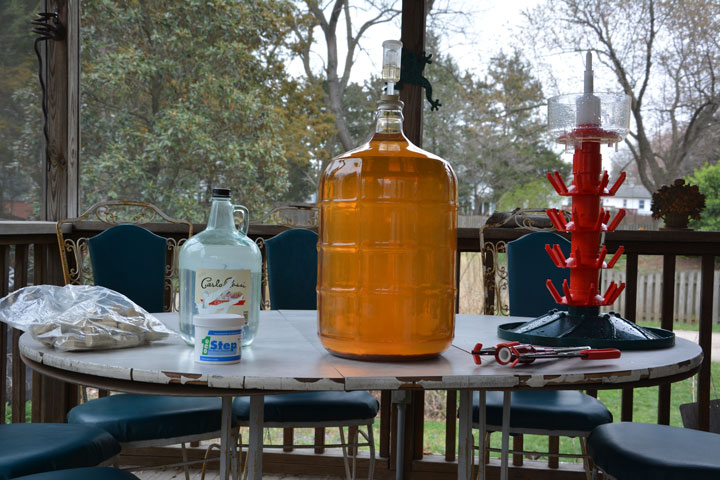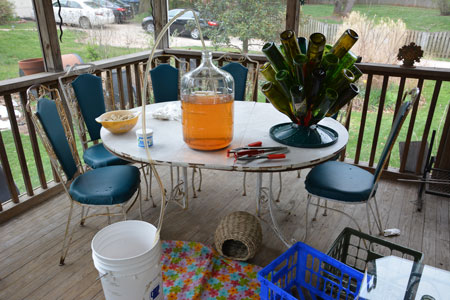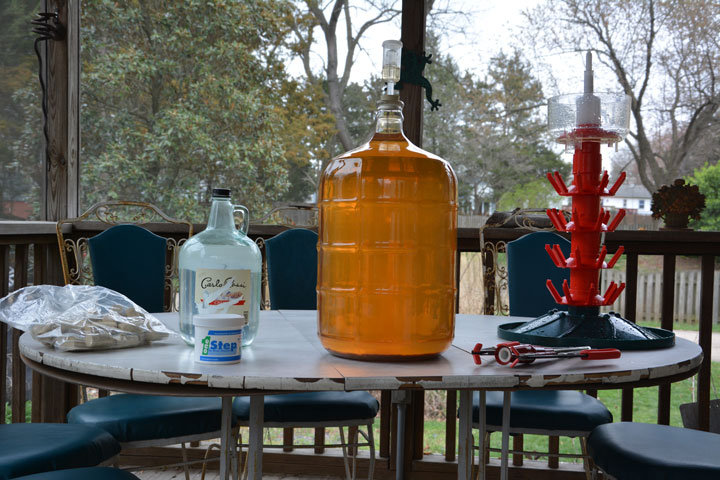Both relaxing and rewarding, if you’re patient enough to wait for your pipeline to fill with homemade product.
I got my start into home wine making partly inspired by Ray Bradbury’s story Dandelion Wine. The thought of being able to capture time in a bottle, not just any time but summertime, caught my fancy. During the long, cold, dark nights of winter you could pop the cork, smell the sweet intoxicating scents of summer and dream of happier times.
One of the first signs of spring to make their appearance is those hearty yellow flowers beginning to bloom. I walked to the local library where they could be picked without fear of contaminants, such as weed killers. Here’s a dandelion wine recipe for the curious. Dandelions don’t make the best ingredient for wine making, they have none a the raw materials which fermentation depends upon, like sugars. While it’s fun, relatively easy and rewarding dandelions aren’t in the same class as natures sweetest fruit, the grape.
Basic skills needed for home wine making
If you can follow a basic recipe and have the patience to wait for the wine to complete it’s rest in the bottle, then you can probably make good wine. Notice how I encapsulated the algorithm in an if/then statement.
# Wine making algorithm
boolean patient = true
if (patient) {
result = "You will probably be able to create great wines"
} else {
result = "Continue buying overpriced product from your merchant"
}
return resultWith the successful venture of dandelion wine under my belt, I was ready to branch out into uncharted waters, but keeping my boat close to the shore. For me it was a step-by-step process, taking baby steps first. Scouring the internet for recipes I also found a number of home brew suppliers which also carried wine making equipment and juices.
My favorite among these was Midwest Brewing, they had a great catalog which I could browse through offline. While tempted to pick up home brewing, it was apparent from the 80+ pages that I could pump thousands of $’s into home brewing and would probably need to add an addition onto the hacienda to keep it all. No, wine making for me was a simpler proposition taking up far less storage space and if I decided to bail out on the hobby there would be less surplus to sell off on eBay.
After you have a basic starter kit, you can get wine a recipe kit which includes the pressed juice from some of the best wine regions around the world. There’s usually 5-6 steps to follow and all of the ingredients needed to produce a batch of 30 bottles in 30 days. A little back of the envelope math shows that you can get in for between $2 – $5 per bottle, depending on the quality of the juice you buy. Juices from world class regions will cost you about $5 per bottle, but if you prefer good wine it’s worth it.

If you’re like me, you’ll start with a modestly priced wine to get the kinks out of your manufacturing process, then increase the juice ingredient cost as your process improves. In about half a year you can have a substantial wine cellar. Shown on the left is a can of 1 step cleaning powder which you mix 1 tbsp with a gallon of water. The cleaner is used on all our wine making equipment and bottles. It’s both sanitary and food safe. The worst enemy to wine making is uninvited contaminants, which the cleaning solution remedies. Also shown in the picture are a bottle corker and corks.
To save some $’s on bottles and their shipping cost, I discovered that if you over-tip the wait staff at wine bars they’re only too happy to save their empty bottles for you. I know that some of you are thinking you could leave the labels on the expensive bottles, refill them with your homemade wine, heat shrink a new hat over the cork and voila! If you’re thinking about trying something like this, my answer to that is: no, no, no and no. It’s been tried before, and aside from being unethical and illegal it’s also uncool, so don’t do it.
When your fermentation is complete, when the wine has clarified and stabilized you’re ready to begin bottling.

The bottle tree has a manual pump in the bowl on top, you add some of the cleaning solution and pump until the bottle is clean.
Decorate the tree with the bottles and the cleaner drains out. While the bottles are draining you can siphon the wine from the carboy into the primary fermentation bucket. It’s a food grade container and you shouldn’t try improvising with one which isn’t. I have an extra one with a spigot which I use to fill the bottles.
During the bottle washing process I also added the corks to a bowl with the cleaning solution. The wet cork will be easier to get into the bottles. When bottling is complete they should be left in your basement standing up for a few days. Label your bottles, record when they were bottles and what you made. Then you should forget about them for at least a year. Certainly any leftovers or bottles that can’t be filled up to the shoulders should be kept aside and tasted during the process.
There should be a small air gap between the bottom of the cork and the shoulders of the bottle. If you cant fill the bottle you may as well drink it. Your wine will improve with time, so temper your expectations when consuming an immature bottle.
The wine shown in the pictures comes from our own modest vineyard, it’s a mix of concord and muscadine grapes, which are indigenous to our region, but not sought after in terms of quality wine. They’re better for jam, but I wanted to try a recipe from scratch. Last year the hot dry season produced an exceptional crop of grapes, I made the batch following these guidelines.
When you’re ready to try a recipe from scratch, consider buying 50 – 100 pounds of grapes from a local vineyard. You’ll need a fruit press to crush the grapes and a source for the other ingredients which come in the kit.
I hope you enjoyed this brief introduction and a ready to put these new learning skills to good use!
